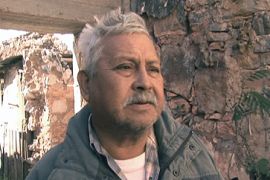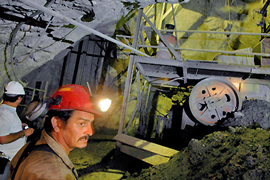Mexicans up in arms against mine
Residents complain San Xavier mine has damaged ecology and contaminated the water.

Armando Mendoza points to the huge cracks in the walls of his house in San Pedro, Mexico.
Gesturing to the ceiling that recently fell in, he shows the damage caused by the daily explosions from the Canadian-owned mine San Xavier, which crouches over this small village.
Keep reading
list of 4 itemsAfter the Hurricane
World’s coral reefs face global bleaching crisis
Why is Germany maintaining economic ties with China?
Armando is one of the residents who opposed the mine when it was proposed by New Gold, the Canadian gold-mining company, in 1996.
The community has been bitterly split over the project, which has brought jobs to some, but also razed the hill behind this former tourist destination.
The explosions from the mines have caused fast-spreading damage, breaking apart buildings, including a colonial-era church.
But now, the local population have also had to contend with wire fences set up around the roads, marking off the green spaces within the village.
Armando says they were erected by local authorities in collusion with the mine.
“The fences have been put up by the mine to get us out, so that we don’t have space to move. That is the ambition of this company, that we leave the village,” he said.
Access to mineral wealth
San Xavier is owned by the Corporation New Gold, one of several Canadian mining companies attracted to Mexico by low royalty payments, an accommodating government and easy access to mineral wealth under relaxed Mexican laws.
Opponents of the mine claim that it has already wreaked irreversible environmental damage on the region, introducing cyanide into the water system that serves the state capital.
The region, with its rare species of cactus and fauna, was in the process of becoming a protected environmental site.
Now the area exploited by the mine resembles a lunar crater.
For their part, the mine operators say that they constantly monitor subterranean water to check contamination levels and that the company has rescued more than 23,330 cacti from five protected species, as well as pursuing a reforestation plan.
Hector Barrí, the local lawyer who heads the legal opposition to the mine, has obtained three federal tribunal orders to cease its operation on environmental grounds.
Resistance
However, the Mexican Environmental Secretary (SEMARNAT) has so far failed to enforce the sentence, allowing the mine to continue operating.
 |
| Environmental authorities have not yet enforced a ban on the mine’s operations [EPA] |
With the latest court order against the mine, decreed this October, Barri feels the government will now be forced to act.
“The Mexican environmental secretary cannot give a third permission [to Mina San Xavier] because it would be obvious that it had sold itself to a transnational company.”
In the meantime, local residents continue to oppose the mine despite the dangers they may face.
Enrique Rivera Sierra, a lawyer and protester, was badly beaten whilst handing out literature against the mine.
Fellow activists say that the case against the two attackers has been shelved indefinitely by the local authorities.
In other parts of the country the government has intervened against anti-mine protesters.
This August in Chiapas, Southern Mexico, activist Mariano Abarca was herded into an unmarked van by gunmen and then held for three days without contact with his family.
Reports later indicated that the capture was actually an arrest by undercover state police.
Economic revival?
Claims that the mines bring economic revival and employment opportunities to local communities are disputed by Valeria Scorza of non-governmental organisation PRODESC.
|
“The local town economy and investment becomes linked to the mining industry … That’s why you see phantom villages where the mine has closed” Valeria Scorza, PRODESC |
She says that the jobs are fleeting and that the environmental and eventual economical cost is high.
“The life of a mine on average is between 15 and 20 years. Obviously if it is an open pit mine it causes ecological devastation and enormous health problems. Also the local town economy and investment becomes linked to the mining industry.
“So there is no development of other economical activities which can be sustainable in the long-term future.
“That’s why you see phantom villages where the mine has closed, there’s no economy for people to work in and there is a large amount of migration.”
It is unlikely that Canadian firms will stop their rush for precious metals in Mexico with important new discoveries still being made.
The poor southern states of Oaxaca and Chiapas appear top of their list with 72 mining concessions already granted in Chiapas alone between 2003 and 2006, according to a report titled ‘Made in Canada Violence: Mining in Mexico’.
With little help from the Mexican government, it will be left to those local communities to fight alone for their water, their livelihoods and their land.